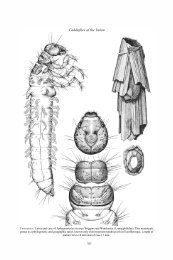No. 9 1998 ARC TIC IN SECT NEWS - Department of Biological ...
No. 9 1998 ARC TIC IN SECT NEWS - Department of Biological ...
No. 9 1998 ARC TIC IN SECT NEWS - Department of Biological ...
Create successful ePaper yourself
Turn your PDF publications into a flip-book with our unique Google optimized e-Paper software.
4 <strong>ARC</strong><strong>TIC</strong> <strong>IN</strong><strong>SECT</strong> <strong>NEWS</strong> <strong>No</strong>. 9, <strong>1998</strong><br />
FEATURE LOCALITY: TRUELOVE LOWLAND, DEVON ISLAND, CANADA<br />
James K. Ryan<br />
Ryan and Hilchie <strong>Biological</strong> Consultants Ltd., 8613 - 108 A St., Edmonton, Alberta Canada T6E 4M7<br />
Truelove Low land, north coast <strong>of</strong> Devon Is land,<br />
N.W.T., Can ada 75°33′N, 84°40′W<br />
Tem per a ture (1970-73): 278 de gree days above<br />
0°C, 75 days above 0°C, July mean tem per a ture<br />
6.3° C.<br />
Hab i tats: Mo saic <strong>of</strong> sedge-moss mead ows,<br />
cush ion plant com mu ni ties, dwarf shrub<br />
heath; beach ridges; hummocky tun dra;<br />
lakes, ponds, streams; rocky coast;<br />
Pre cam brian shield.<br />
Veg e ta tion: 96 pe ren nial vas cu lar plant<br />
spe cies, 182+ li chen spe cies, 126<br />
di a tom taxa, 132 moss spe cies, 30<br />
hepatic spe cies.<br />
Ver te brates: 7 mam mal and 35 bird<br />
spe cies (17-19 spe cies ac tu ally<br />
nest ing), one fish spe cies.<br />
In ver te brates, known spe cies: pro to zoans<br />
61, platyhelminths 1, cestodes 4,<br />
nem a todes many, ro ti fers 66,<br />
annelids 7, tar di grades 13,<br />
crustaceans 13, spi ders 10, mites 22,<br />
Truelove Lowland is the most thoroughly<br />
studied biological research site in the Canadian<br />
Arc tic. The In ter na tional Bi o log i cal<br />
Programme (IBP) studies conducted there from<br />
1970-74, led by Lawrence C. Bliss, generated a<br />
great range <strong>of</strong> ecological information. Centred<br />
on the con cept <strong>of</strong> energy flow through this eco -<br />
system, IBP investigations ranged from perma -<br />
frost, soils and climate through plants, an i mals<br />
and decomposers, and human impacts. The syn -<br />
thesis <strong>of</strong> four field seasons <strong>of</strong> research was thor -<br />
ough, com pre hen sive and compactly presented<br />
by all participating investigators in the project<br />
sum mary (Bliss 1977). Pre vi ous and sub se -<br />
quent stud ies, many by former IBP participants,<br />
have added significantly to the knowledge <strong>of</strong><br />
this site and <strong>of</strong> arctic science.<br />
The Truelove Lowland (Fig. 1) is a 43 km 2<br />
coastal plain, one <strong>of</strong> a series <strong>of</strong> five lowlands on<br />
the northeast coast <strong>of</strong> Devon Island. The site is<br />
bi o log i cally di verse com pared with the sur -<br />
rounding lands, most <strong>of</strong> which are high pla teau.<br />
The Lowland may be called an oasis <strong>of</strong> diver -<br />
sity as it is representative <strong>of</strong> the especially rich<br />
sites that form about 1% <strong>of</strong> the Queen Elizabeth<br />
Islands land area. The tall est vegetation rarely<br />
reaches 5 cm above dry soils—15 cm in mead -<br />
ows—and consists mostly <strong>of</strong> sedges, mosses,<br />
cush ion plants, prone woody shrubs and li -<br />
chens. A variety <strong>of</strong> meadows dom i nates the<br />
land, separated by more than 20 steps <strong>of</strong> relict<br />
beach ridges cre ated as the Lowland uplifted<br />
from the sea 9700-7500 years B.P. Devon Is -<br />
land, 54,100 km 2 , has no permanent hu -<br />
man residents.<br />
Biota<br />
The biota <strong>of</strong> Truelove, summarized in ap -<br />
pendices <strong>of</strong> the project book (Bliss 1977), bears<br />
review and updating.<br />
The flora includes 96 species <strong>of</strong> perennial<br />
vascular plants. Of these, 7 species were con -<br />
sidered dom i nant, 30 common, 44 moderately<br />
abundant, and 15 were rare. Diatoms were not<br />
included in the appendices, but Wolfe and King<br />
(1990) report 126 taxa from 29 genera and 7 or -<br />
ders <strong>of</strong> freshwater diatoms at Truelove. There<br />
were 132 species <strong>of</strong> mosses and 30 <strong>of</strong> he pat ics.<br />
Lichens in clude 182 listed species, with sub se -<br />
quent additions. Altogether 92 species <strong>of</strong> fungi<br />
were iden ti fied from soils, dung, and other<br />
sources. The age distribution <strong>of</strong> freshwater arc -<br />
tic char was studied by James Trask. Thirty-five<br />
species <strong>of</strong> birds were sighted on the Lowland,<br />
<strong>of</strong> which 17-19 species ac tu ally nested during<br />
1970-74. Mam mal in hab it ants con sisted <strong>of</strong><br />
musk oxen and fluctuating low pop u la tions <strong>of</strong><br />
arctic hare, groenland lemming and short-tailed
















